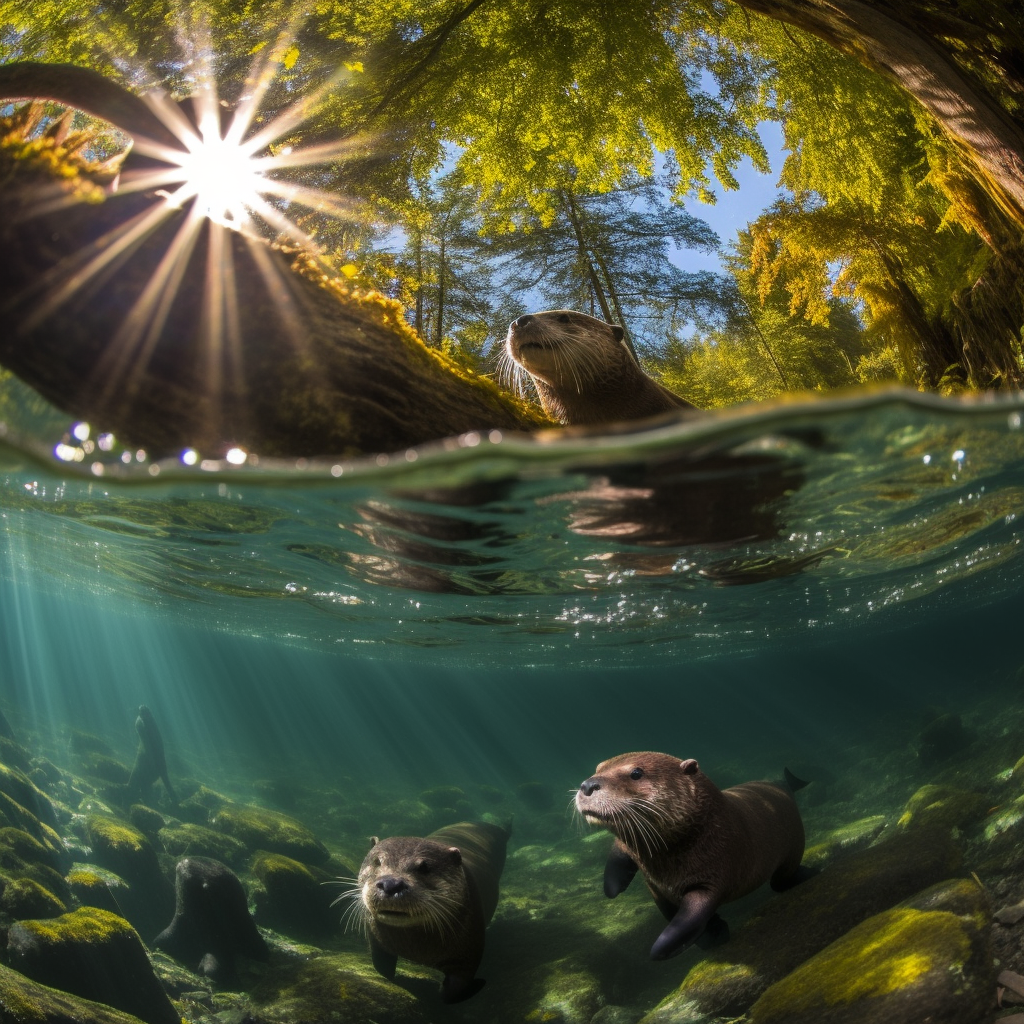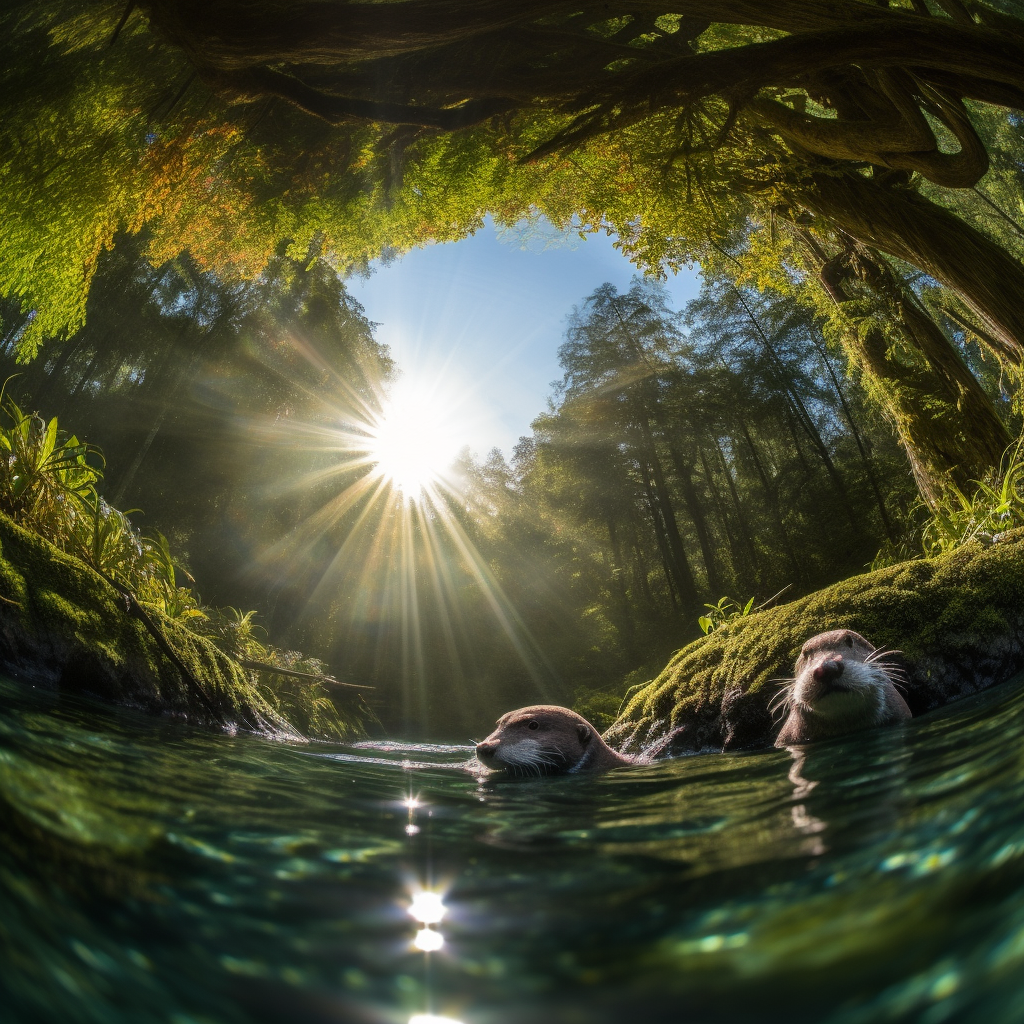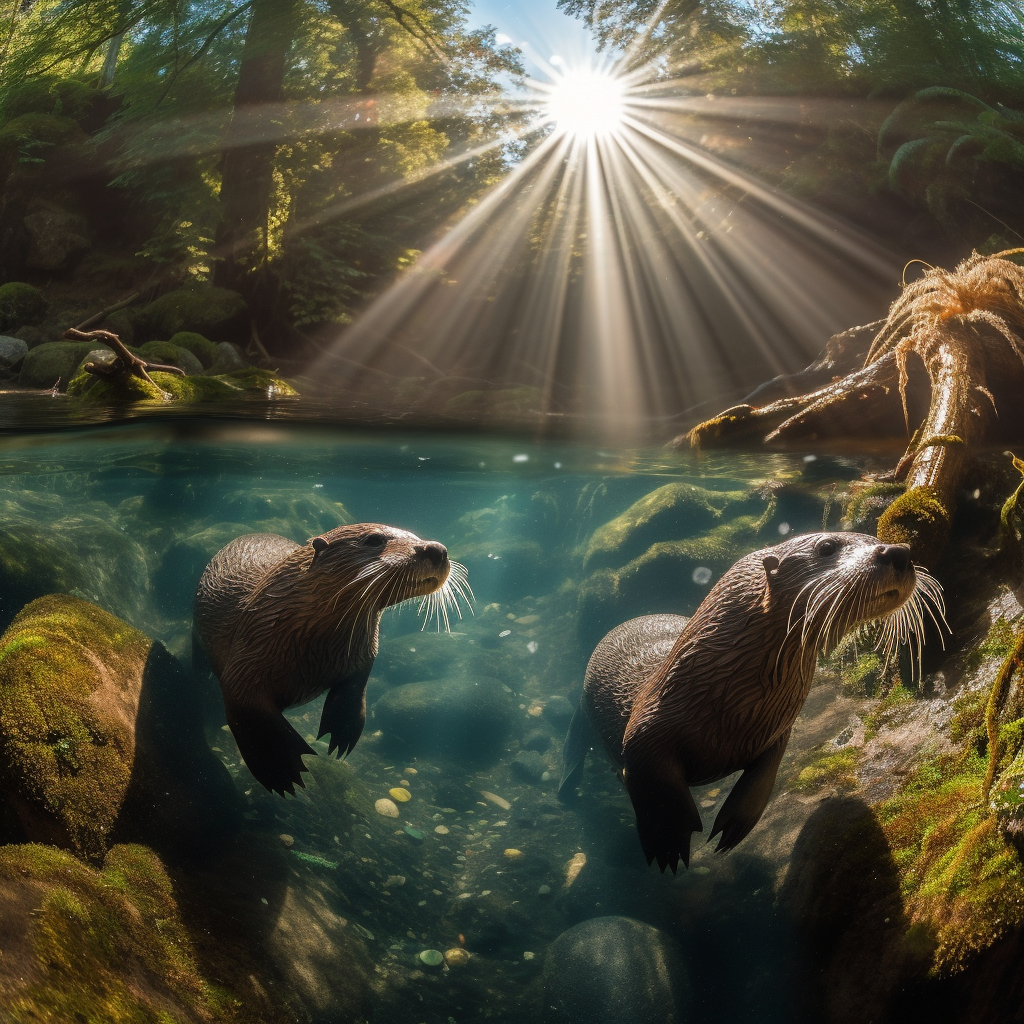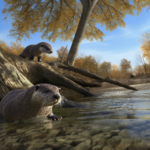River otters are fascinating creatures that can be found in abundance in the beautiful state of Oregon. These playful and intelligent mammals are well-adapted to their aquatic habitat, and their presence in Oregon’s rivers and lakes is a testament to the state’s commitment to preserving its natural ecosystems. In this article, we will explore the world of river otters in Oregon, delving into their behavior, habitat, diet, and conservation efforts. So, let’s dive in and discover the wonders of these charismatic creatures that call Oregon home.
Key Takeaways
- River otters are native to Oregon and can be found in various aquatic habitats such as rivers, lakes, and wetlands.
- They are highly adaptable and can thrive in both freshwater and saltwater environments.
- River otters play a crucial role in maintaining the health of ecosystems by controlling populations of fish and invertebrates.
- They are excellent swimmers and have streamlined bodies, webbed feet, and a thick layer of fur that helps them stay warm in cold water.
- River otters are social animals and often live in family groups, known as rafts.
- Conservation efforts have helped restore river otter populations in Oregon, but they still face threats such as habitat loss and pollution.
The Enchanting World of River Otters in Oregon
A. Understanding the Oregon River Otter: Size and Characteristics
The Oregon River Otter, also known as the North American River Otter, is a fascinating creature that calls the waterways of Oregon home. These playful and charismatic mammals are well-adapted to their aquatic lifestyle and are a delight to observe in their natural habitats.
Size and Appearance
Oregon River Otters are medium-sized mammals, with males typically weighing between 11 to 30 pounds and measuring around 3 to 4 feet in length, including their tail. Females are slightly smaller, weighing between 9 to 24 pounds. These otters have long, streamlined bodies, which are perfect for navigating through the water with ease. Their fur is dense and waterproof, providing insulation and protection from the cold waters they inhabit.
Behavior and Adaptations
River otters are highly social animals and are often found in family groups known as “romps.” They are known for their playful nature, frequently engaging in activities such as sliding down muddy banks or chasing each other in the water. Otters are excellent swimmers, thanks to their webbed feet and strong tails, which help propel them through the water. They can stay submerged for several minutes, using their keen eyesight and sensitive whiskers to locate prey.
B. The Habitats: Where to Spot River Otters in Oregon
Oregon is blessed with an abundance of diverse habitats that provide ideal conditions for river otters. These charismatic creatures can be found in various waterways across the state, from rivers and lakes to coastal estuaries. Here are some of the top spots to catch a glimpse of these playful otters:
-
Crater Lake National Park: The pristine waters of Crater Lake offer a perfect habitat for river otters. Keep an eye out for them near the lake’s edges, where they can often be seen swimming and fishing.
-
Willamette River: This major river in Oregon is home to a thriving population of river otters. Look for them near the riverbanks, especially in areas with dense vegetation and rocky outcrops.
-
Columbia River: The mighty Columbia River is another prime location to spot river otters. Head to the river’s estuaries and marshy areas, where these otters can be seen foraging for fish and other prey.
-
Deschutes River: Known for its scenic beauty, the Deschutes River is also a haven for river otters. Look for them near the river’s rapids and rocky areas, where they often build their dens.
C. The Pups: A Glimpse into the Life of Oregon River Otter Pups
One of the most endearing aspects of river otters in Oregon is their adorable pups. These playful bundles of fur are born in spring or early summer and bring joy to anyone lucky enough to witness their antics. Here’s a glimpse into the life of Oregon river otter pups:
Birth and Development
Female otters give birth to litters of two to four pups, which are born blind and helpless. The mother provides constant care and protection, nursing them and teaching them essential survival skills. As the pups grow, they become more independent and start exploring their surroundings under their mother‘s watchful eye.
Playful Learning
Pups learn important life skills through play. They engage in mock fights, practice swimming, and even slide down muddy banks for fun. These playful activities help them develop their coordination, hunting techniques, and social bonds within the romp.
Growing Up and Leaving the Den
After about three to four months, the otter pups are ready to venture out of the den and explore the world with their family. They continue to learn from their parents and older siblings, honing their swimming and hunting abilities. By the time they reach one year of age, they are considered fully independent and ready to establish their own territories.
Oregon’s river otters are a true treasure, adding charm and vitality to the state’s waterways. With their playful nature, unique adaptations, and the joy of observing their adorable pups, these otters are a beloved part of Oregon’s wildlife. So, keep your eyes peeled and your camera ready for an enchanting encounter with these delightful creatures in their natural habitats.
River Otters Across the United States
River otters are fascinating creatures that can be found in various parts of the United States. While they are commonly associated with Oregon, they can also be spotted in other states across the country. In this section, we will explore the distribution of river otters and compare their presence in Oklahoma with that in Oregon.
A. River Otters in Oklahoma: A Comparison with Oregon
When it comes to river otters, Oregon is often hailed as one of the best places to observe these charismatic creatures. With its abundant waterways and diverse ecosystems, the state provides an ideal habitat for otters to thrive. However, river otters are not exclusive to Oregon alone.
In Oklahoma, river otters can also be found, although their population is not as dense as in Oregon. The state’s water bodies, including rivers, lakes, and wetlands, offer suitable environments for otters to establish their territories. While they may not be as commonly seen as in Oregon, otter sightings in Oklahoma are still possible, especially in areas with higher concentrations of water sources.
B. The Distribution: What States Do River Otters Inhabit?
River otters have a widespread distribution across the United States. They can be found in various states, each with its own unique otter population. Apart from Oregon and Oklahoma, river otters can be spotted in states such as California, Washington, Alaska, Louisiana, and Florida, among others.
The Pacific Northwest, including Oregon and Washington, is known for its thriving otter populations. These states offer an abundance of freshwater habitats, including rivers, lakes, and estuaries, which serve as prime otter territories. The coastal regions of California also provide suitable environments for otters to flourish.
Moving eastward, states like Louisiana and Florida are home to river otters as well. In these regions, otters can be found in both freshwater and brackish water habitats, including swamps, marshes, and coastal areas. The diverse range of ecosystems in these states contributes to the survival and adaptability of river otters.
Here is a table summarizing the distribution of river otters across select states in the United States:
| State | Notable Otter Populations | |————-|————————–| | Oregon | Abundant | | Oklahoma | Moderate | | California | Thriving | | Washington | Flourishing | | Alaska | Substantial | | Louisiana | Sustained | | Florida | Viable |
As you can see, river otters have managed to establish themselves in various states, adapting to different environments and water sources. Their presence across the United States showcases their resilience and ability to thrive in diverse ecosystems.
In the next section, we will delve deeper into the behavior and ecology of river otters, shedding light on their fascinating traits and habits.
The Importance of River Otters in Ecosystem

A. The Vital Role of River Otters in the Ecosystem
River otters play a crucial role in the delicate balance of ecosystems, particularly in the rivers and waterways of Oregon. As native North American river otters, they have adapted to thrive in various habitats, including rivers, lakes, and coastal areas. These charismatic creatures are not only a delight to observe but also serve as indicators of a healthy ecosystem.
One of the primary reasons why river otters are vital to the ecosystem is their impact on the food chain. As opportunistic predators, they help control the population of various aquatic species, including fish, amphibians, and invertebrates. By preying on these animals, otters help maintain a balanced population, preventing any one species from dominating and disrupting the ecosystem’s equilibrium.
Moreover, otters also contribute to nutrient cycling within their habitats. When otters consume their prey, they excrete waste that contains essential nutrients. These nutrients, such as nitrogen and phosphorus, are then released back into the environment, enriching the surrounding vegetation and supporting the growth of aquatic plants. This process is crucial for maintaining a healthy ecosystem and ensuring the overall productivity of the waterways.
B. Why River Otters are Important: A Deeper Insight
Beyond their direct impact on the food chain and nutrient cycling, river otters have several other important roles in the ecosystem. Let’s take a deeper look at some of these roles:
-
Indicator Species: River otters are considered indicator species, meaning their presence or absence can indicate the overall health of an ecosystem. Since otters require clean water and abundant food sources, their presence suggests a well-functioning and balanced ecosystem. Monitoring otter populations can help scientists assess the overall health of rivers and waterways in Oregon.
-
Ecosystem Engineers: River otters are known as ecosystem engineers due to their ability to modify their habitats. They create dens along riverbanks, which not only provide shelter for themselves but also benefit other species. These dens can serve as homes for other animals, such as muskrats, minks, and even amphibians. By creating these habitats, otters contribute to the overall biodiversity of the ecosystem.
-
Seed Dispersers: River otters play a role in seed dispersal. As they move between different habitats, they may inadvertently carry seeds on their fur or in their feces. This helps in the dispersal of plant species, contributing to the diversity and regeneration of vegetation along riverbanks and surrounding areas.
-
Tourism and Education: River otters are charismatic and captivating animals, attracting tourists and nature enthusiasts. Their presence in Oregon’s waterways provides opportunities for people to engage in wildlife viewing and learn about the importance of conservation. This, in turn, generates economic benefits for local communities and raises awareness about the need to protect these precious creatures and their habitats.
In conclusion, river otters in Oregon play a vital role in maintaining the health and balance of ecosystems. From controlling populations to nutrient cycling and habitat modification, these charismatic creatures contribute to the overall well-being of rivers and waterways. Recognizing their importance and implementing conservation efforts is crucial for preserving the delicate ecosystems they inhabit. So, next time you spot a playful otter in Oregon’s waterways, take a moment to appreciate the significant role it plays in the intricate web of life.
The Interaction Between River Otters and Humans

A. Are River Otters Dangerous?
River otters are fascinating creatures that inhabit the waterways of Oregon. They are known for their playful nature and sleek, streamlined bodies that allow them to glide effortlessly through the water. But what about their interaction with humans? Are river otters dangerous?
The answer is no. River otters are generally not dangerous to humans. They are not known to attack or harm people unless they feel threatened or cornered. In fact, river otters are quite shy and elusive, preferring to avoid human contact whenever possible.
While river otters may be curious and occasionally approach humans, they are more likely to retreat if they sense any danger. It is important to remember that these animals are wild and should be observed from a safe distance. Feeding or attempting to touch river otters can disrupt their natural behavior and may even lead to negative consequences for both humans and otters.
B. The Human-Otter Interaction: A Balanced Perspective
The interaction between humans and river otters in Oregon can be seen as a delicate balance. On one hand, humans have a responsibility to respect and protect the natural habitats of these incredible creatures. On the other hand, river otters play a vital role in maintaining the health and balance of river ecosystems.
River otters are considered a keystone species, meaning they have a disproportionate impact on their environment compared to their abundance. They help regulate fish populations, control invasive species, and improve water quality through their feeding habits. By protecting river otters and their habitats, we are indirectly safeguarding the overall health of our rivers and waterways.
To ensure a harmonious coexistence between humans and river otters, it is crucial to follow certain guidelines when encountering these animals in the wild. Here are some tips for a responsible human-otter interaction:
-
Observe from a distance: Enjoy watching river otters from a safe distance, using binoculars or a camera with a zoom lens. This allows you to appreciate their natural behavior without disturbing them.
-
Do not feed otters: Feeding river otters can disrupt their natural diet and behavior. It can also lead to dependency on humans for food, which can have negative consequences for their long-term survival.
-
Respect their space: Avoid approaching river otters too closely or attempting to touch them. Give them the space they need to feel comfortable and secure in their environment.
-
Dispose of trash properly: Properly dispose of trash and fishing gear to prevent entanglement or ingestion by river otters. This helps protect both the otters and their habitat.
By following these guidelines, we can ensure that our interactions with river otters in Oregon are respectful and beneficial to both humans and these incredible creatures. Let us appreciate their beauty and playfulness from a distance, while also working towards their conservation and the preservation of their natural habitats.
Attracting River Otters: A How-To Guide

A. The Otter Ocean Code: Understanding Otter Behavior
River otters, also known as North American river otters, are fascinating creatures that inhabit various waterways in Oregon. To attract these playful and curious mammals, it’s essential to understand their behavior and preferences. By following the Otter Ocean Code, you can create an environment that appeals to these delightful creatures.
1. Otter Habitats
River otters thrive in a variety of habitats, including rivers, lakes, ponds, and coastal areas. They are highly adaptable and can be found in both freshwater and marine environments. When planning to attract river otters, consider the type of habitat available in your area. If you live near a river or lake, you have a higher chance of spotting these charismatic creatures.
2. River Otter Behavior
River otters are social animals that live in family groups known as rafts. These rafts typically consist of a female otter, her offspring, and sometimes a male otter. They communicate through a series of vocalizations, including chirps, whistles, and growls. River otters are excellent swimmers and spend a significant amount of time in the water, where they hunt for fish, amphibians, and crustaceans.
3. Otter Spotting Tips
If you’re eager to catch a glimpse of river otters in their natural habitat, here are a few tips to increase your chances:
- Visit waterways during early morning or late evening when otters are most active.
- Look for signs of otter activity, such as tracks, slides, and scat near the water’s edge.
- Find a quiet spot and be patient. River otters are elusive creatures and may take some time to appear.
- Bring binoculars or a camera with a zoom lens to observe otters from a distance without disturbing them.
B. Practical Tips to Attract River Otters
Now that you have a better understanding of river otter behavior, let’s explore some practical tips to attract these captivating creatures to your area.
1. Create a Welcoming Habitat
To entice river otters, it’s crucial to provide a suitable habitat. Consider the following:
- Ensure there is a clean and accessible water source nearby, such as a pond or river.
- Plant native vegetation along the water’s edge to provide cover and create a natural environment.
- Avoid using harmful chemicals or pesticides that can contaminate the water and harm otters and their prey.
2. Offer a Varied Diet
River otters have a diverse diet that includes fish, amphibians, and crustaceans. To attract them, consider providing a variety of food sources:
- Stock your pond or lake with fish species that are native to your area.
- Create a small wetland area where amphibians can thrive, attracting otters looking for a tasty meal.
- Place bird feeders near the water’s edge to attract small fish, which can entice otters.
3. Provide Shelter and Resting Areas
River otters require safe and comfortable places to rest and seek shelter. Consider the following:
- Install floating platforms or logs in the water to provide resting spots for otters.
- Create burrows or dens along the water’s edge using natural materials like rocks and logs.
- Avoid disturbing otter habitats by keeping a respectful distance and minimizing human activity in the area.
By implementing these practical tips and understanding river otter behavior, you can increase the likelihood of attracting these charming creatures to your local waterways. Remember to respect their natural habitat and observe them from a distance to ensure their well-being. Happy otter spotting! Conclusion
In conclusion, river otters in Oregon are fascinating creatures that play a vital role in the state’s ecosystems. These playful and intelligent animals are well-adapted to their aquatic habitats and are known for their excellent swimming and diving skills. River otters are an important indicator species, as their presence indicates a healthy and thriving ecosystem. They are also a delight for wildlife enthusiasts and nature lovers, who can observe them in their natural habitats along Oregon’s rivers and lakes. However, it is crucial to remember that these animals are wild and should be respected from a distance. By protecting their habitats and ensuring the conservation of their populations, we can continue to enjoy the presence of river otters in Oregon for generations to come.
Frequently Asked Questions
How can I attract river otters to my property?
Attracting river otters can be a tricky task as they are wild animals and have specific habitat requirements. They are typically attracted to clean, unpolluted water bodies with an abundant food supply, such as fish and crustaceans. Providing a safe environment with plenty of hiding spots like logs and vegetation can also help. However, it’s important to remember that otters are protected species in many areas, and any interactions should not disturb their natural behavior.
What rivers do otters live in?
North American river otters, including those in Oregon, can be found in a variety of water habitats, including rivers, streams, lakes, ponds, and marshes. They are quite adaptable and can live anywhere that has a food supply and is close to water. In Oregon, they are often spotted in the Columbia River, Willamette River, and their tributaries.
What is the ‘otter ocean code’?
The term ‘otter ocean code‘ is not a recognized term in otter ecology or conservation. It could be a misunderstanding or miscommunication. If you’re looking for information about otters in marine habitats, you might be interested in learning about sea otters, a different species than river otters.
Are there river otters in Oklahoma?
Yes, river otters are found in Oklahoma. They were once nearly extinct in the state due to fur trapping, but conservation efforts have helped the population to recover. They are now found in several waterways across the state.
How big are Oregon river otters?
Oregon river otters, which are a type of North American river otter, typically measure about 3 to 4 feet long, including their tail. They can weigh between 11 and 30 pounds, with males being larger than females.
Where can I see river otters in Oregon?
River otters can be spotted in several locations in Oregon. Some popular spots include the Tualatin River, Sauvie Island, and the wetlands around Fernhill. The Oregon Zoo in Portland also has a river otter exhibit.
Why are river otters important to the ecosystem?
River otters play a crucial role in maintaining the health of river ecosystems. They are top predators and help control the populations of their prey, like fish and crustaceans. Their foraging behavior also helps to distribute nutrients within the ecosystem. Additionally, their presence can be a good indicator of a healthy, unpolluted ecosystem.
Are there any specific details about Oregon river otter pups?
Oregon river otter pups are usually born in late winter or early spring. They are born blind and helpless but grow quickly under the care of their mother. By fall, they are usually ready to establish their own territories.
Are river otters dangerous?
River otters are generally not dangerous to humans unless they feel threatened or cornered. They are wild animals and should be observed from a distance. If they feel threatened, they may bite or scratch to defend themselves.
What efforts are being made for otter conservation in Oregon?
In Oregon, various efforts are being made to conserve otter populations. These include habitat restoration projects, research on otter ecology and behavior, and public education about otters and their importance to the ecosystem. The Oregon Department of Fish and Wildlife also monitors otter populations and enforces laws protecting otters from harm.




